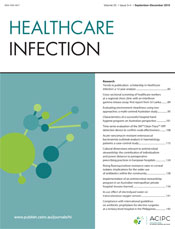
Healthcare Infection
Volume 20 Numbers 3 & 4 2015
HI15008Trends in publication scholarship in Healthcare Infection: a 12-year analysis
The dissemination of information, particularly new information in the form of research, is critical to all professions. This study examined the nature and content of articles published in Healthcare Infection over time, and revealed that approximately half the published manuscripts were research based. Generating and disseminating new knowledge from research is critical to the growing profession of infection prevention and control.
HI15008 Abstract | HI15008 Full Text | HI15008PDF (110 KB) Open Access Article
HI15002Cross-sectional screening of healthcare workers at a regional chest clinic with an interferon gamma release assay: first report from Sri Lanka
Healthcare workers are at high risk of getting infected with tuberculosis in countries where the disease is endemic (prevalent). Here we show that an interferon gamma release assay (IGRA) has no advantage over the cheaper tuberculin skin test (TST) in screening these workers in this setting. Although IGRAs are recommended for screening and have been shown to have many advantages over the conventional TST, this test should be used based on applicability and usefulness evaluated in a local setting.
HI15009Evaluating environment cleanliness using two approaches: a multi-centred Australian study
Environmental cleanliness is a key component of preventing healthcare-associated infections. A standardised method to evaluate environmental cleanliness using two approaches was developed. This paper describes the development process and the findings of the first 12 months of data following the introduction of a standardised program for evaluating environmental cleanliness within Tasmanian healthcare facilities.
HI15009 Abstract | HI15009 Full Text | HI15009PDF (402 KB) Open Access Article
HI15007Characteristics of a successful hospital hand hygiene program: an Australian perspective
Hand hygiene is well established as being fundamental in infection control programs for preventing and controlling HAIs. This paper will describe a successful hand hygiene program, aimed at effecting culture change, which significantly improved and maintained hand hygiene compliance from 22% to 71%, tripling the use of alcohol-based handrub.
HI15011Time series evaluation of the 3M™ Clean-Trace™ ATP detection device to confirm swab effectiveness
Healthcare-associated infections (HAIs) continue to be a global issue contributing to thousands of deaths each year. This study set out to determine the effectiveness of the swab 3M™ Clean-Trace™ ATP System over time in determining the cleanliness of surfaces, which could help lower HAIs. ATP bioluminescence is not sensitive enough to distinguish between viable organisms and organic debris remnants on sterilised equipment.
HI15013Acute vancomycin-resistant enterococcal bacteraemia outbreak analysis in haematology patients: a case-control study
A contained vancomycin-resistant enterococcus bacteraemia outbreak case-control analysis in a haematology cohort. The aim of this analysis was to determine the aetiology of this rare and potentially fatal event, and revealed that recent ward relocation, as well as several patient factors, likely contributed. These results aid in minimising future risk of bacteraemia outbreak.
HI15010Cultural dimensions relevant to antimicrobial stewardship: the contribution of individualism and power distance to perioperative prescribing practices in European hospitals
There are many influences on the decision to prescribe antibiotics, including culture. We found that in European countries there was an association between some cultural characteristics and the inappropriate use of antibiotics. Societal and cultural factors should be considered when designing interventions to improve antibiotic prescribing.
HI15014Rising fluoroquinolone resistance rates in corneal isolates: implications for the wider use of antibiotics within the community
Antibiotic resistance is a major concern for both clinicians and the community at large. Our study reports an increase in fluoroquinolone resistance rates from samples obtained from community-acquired cases of microbial keratitis between 2014 (6.6%) and 2000 (0%; P = 0.002). This data provides some insight into the shifting pattern of antibiotic resistance and, if replicated, would advocate for greater antibiotic stewardship within the community.
HI15015Implementation of an antimicrobial stewardship program in an Australian metropolitan private hospital: lessons learned
Most resources to guide the implementation of antimicrobial stewardship (AMS) programs are tailored around the public hospital system and fail to take into consideration the limitations faced by private hospitals. By tailoring our AMS program to accommodate the needs and barriers at a private hospital, we have implemented several AMS initiatives, including a formulary restriction. We hope that our experiences in establishing an AMS program in a private hospital will aid others in similar situations.
HI15015 Abstract | HI15015 Full Text | HI15015PDF (247 KB) Open Access Article
HI15017In-use effect of electrolysed water on transcutaneous oxygen sensors
Sensitive electrical clinical equipment cannot be easily decontaminated between patients. This study examined the effect of neutral electrolysed water for decontaminating electrical probes used for measuring transcutaneous oxygen concentrations. Electrolysed water appeared to eliminate the risk of pathogen transmission without compromising monitoring data. This product could be useful for decontaminating similar clinical equipment.
HI15018Compliance with international guidelines on antibiotic prophylaxis for elective surgeries at a tertiary-level hospital in the Philippines
Infections in surgical wounds can be prevented by the use of the correct dose of the correct antibiotic at the correct time before or during surgery. This research from the Philippines assessed how well surgical teams follow international guidelines on antibiotic use. The study adds to other evidence from around the world that surgical teams often do not follow guidelines and that awareness-raising initiatives within hospitals may be needed.

